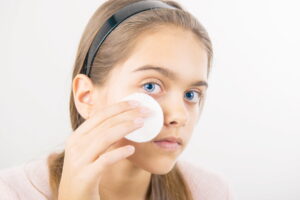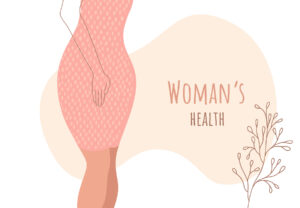By Iris Farrou
07 Sep, 2022
Breast health, Breastfeeding support, Health Conditions and Pregnancy, Lifestyle Tips, Mental Health, New Moms, Prevention, Procedures, Queer Health, Reproductive health, Women's Health, Young adults & teens
BRCA Gene, Breast cancer prevention, Breast cancer screening, Breast Exam, Breast Exam Buffalo NY, Breast Exams at Home, Buffalo NY, Buffalo OB-GYN, Cancer in women, Healthy Lifestyle, Self-Exam, Self-Examination, women's health tips
It is common practice at your regular OBGYN appointment for your doctor to perform a breast
exam, by using their hands and examining the overall the look of your breasts. Though this is no
substitute for a mammogram, which adult women are advised to have done yearly, it is a useful
method to see whether there are any visible or tactile abnormalities on your breasts. In fact, 40%
of breast cancers were diagnosed because women noticed something unusual about their breasts.

Is this something I can do at home?
Absolutely—and it is a good idea to perform a self-breast examination once every month. Consider it a monthly inspection you deserve, and one that at the very least helps you learn your body better. Using your eyes and hands for this examination, you can develop your own breast awareness and be able to immediately identify changes—should there be any, fingers crossed not!
What do I do?
First and foremost, it is important to choose a time of the month when your breast will not be as tender since this can cloud the results of the inspection. Ideally, during a time when you are not menstruating or ovulating. Secondly, remember you can (and probably should) ask your doctor or nurse practitioner for a demonstration on how to do this at home.
The most effective technique is to start with a visual examination of your breasts. Stand shirtless and braless in front of the mirror, with no-shadow casting light if possible, and place your hands at your sides. Look for any changes in size, shape, possible asymmetry, dimpling, or puckering. Check to see if your nipples are inverted. Then, inspect your breasts in a similar manner but after raising your hands above your head, palms pressed together forming an A shape. You can also lift your breasts and inspect whether the ridges on the bottom are symmetrical. Should you not trust your own vision, or if you have a visual impairment, it’s a good idea to ask a partner, trusted family member or friend, to help you with this.
Is this all?
The visual inspection is the first step. Next, you want to use the pads of your three middle
fingers. If you can’t sense very well with the pads of your fingers you can use your palm or the
backs of your fingers. You can do the tactile inspection in the shower or lying down (that way,
the breast tissue spreads and it’s easier to feel).
Now, take your time, don’t rush, and establish a routine for this part. If you do it clockwise every
time, for example, and in the same order, then after a few times you will be better able to judge
any changes in the pattern of your breasts. The goal here is to feel the depths of the breast using
different levels of pressure—so you can go over the whole tissue. Closest to the skin, use light
pressure. As you go try to feel a little deeper, use medium pressure. Closest to the chest and ribs,
use firmer pressure.
Remember that you are not looking for anything in particular, you are just learning the patterns
of your breasts. So, take deep breaths, take your time, remind yourself this is being done
absolutely for preventative reasons—just like flossing!
More
 Probably every parent’s concern is that their child is developing in the best possible, healthy way. You may have heard of developmental milestones, but what do they really mean?
Probably every parent’s concern is that their child is developing in the best possible, healthy way. You may have heard of developmental milestones, but what do they really mean?
First and foremost is important to remember that every age has different developmental characteristics and milestones you should keep an eye on. When it comes to a newborn, parents are mostly keeping track of movement, visual and hearing, and social and emotional milestones. When you have a toddler, you start paying attention to hand and finger skills, as well as language and cognitive development.
Why is it Important?
The CDC reports that 1 in 6 children aged 3-17 have at least one developmental, or behavioral, disability. The problem is that many children are not diagnosed until they are in school, by which time the window of opportunity for important treatments may have passed, and significant delays may have taken place. The good news is there are ways for you to monitor your child’s development! The CDC offers not only a Checklist by age, but also a Milestone Tracker App you can use.
The Process
- Monitoring
Developmental milestones can easily be monitored at home, with the help of some simple resources. Remember that what they refer to are things about 75% of children can do by a certain age. You can observe how your child grows and changes over time, and whether they meet the typical milestones of their age.
- Screening
If you have concerns, or notice a milestone is missed, then you can proceed with developmental screening, a closer look, and a test to see how your child is developing. Though it can be a part of regular health screenings, a doctor can use a questionnaire and checklist to monitor your child’s progress in language, thinking, movement, behavior, and emotions. The American Academy of Pediatrics suggests developmental and behavioral screenings at ages of 9, 18, and 30 months, regardless of concern. In addition, it is recommended that all children be screened for autism spectrum disorder at 18 and 24 months.
- Evaluation
Should an area of concern be found, then your medical professional will usually proceed with a developmental evaluation to try and reach a diagnosis. These are done by trained specialists, such as a developmental pediatrician, child psychologist, or speech-language pathologist, among others. The specialist will observe the child, speak with the caretakers or parents, and even give the child a structured test. Usually, developmental evaluations determine whether a child needs early intervention services or special treatments.
More
 Every parent expects their sweet babies will one day grow into hormonal teenagers, with changes in their appearance and their attitude. Some dread this change, but it’s none other than teens themselves who have to deal with their bodies changing, smelling differently, and deal with skin care and acne!
Every parent expects their sweet babies will one day grow into hormonal teenagers, with changes in their appearance and their attitude. Some dread this change, but it’s none other than teens themselves who have to deal with their bodies changing, smelling differently, and deal with skin care and acne!
What Happens to the Skin?
In a single word: hormones. Puberty begins around age 9 or 10, when the hypothalamus releases a gonadotropin-releasing hormone (GnRH). This hormone travels to the pituitary gland, which is a small gland under the brain that produces hormones which control other hormones in the body. When GnHR reaches the pituitary gland luteinizing hormone (LH) and follicle-stimulating hormone (FSH) are released. These two are responsible for the development of the reproductive system. At the same time, the adrenal glands produce adrenal androgens, which cause body hair growth. But the biggest concern is the skin glands, which produce the natural oil sebum. Puberty hormones increase the amount of sebum, which clogs the pores and causes skin care and acne problems.
Proper Skin Care
The first way to deal with acne is natural methods. It’s important to keep the skin clean by washing gently, and regularly, with warm water and a mild soap. Pat dry with clean tissues to reduce the risk of oil transfer between uses. It’s also important keep your hair away from your face for the same reason: oil transfer. With changing hormones, you may notice your body odor becoming stronger. Regular showers are necessary now more than ever, as bathing ensures your hair is kept clean. Fresh pillowcases can also work wonders!
There are numerous over the counter skin care products you can use when washing your face, and it’s a good idea to exfoliate at least once a week. For persistent pimples, you can try drying them out using some isopropyl alcohol on a cotton round. Cleaning your face with a cotton round dipped in alcohol, or using alcohol wipes, is also a great way to dry out some of the excess oil and help your pores unclog.
Dermatological Methods for Skin Care
Some cases of acne may be more serious, and in need of a dermatologist’s assistance. The first mild, topical, medication a doctor may suggest is retinoid drugs gel or lotion form which is to be applied in the evening and prevents clogging of hair follicles. Azelaic acid is another option, a naturally occurring acid produced by a yeast. It has antibacterial properties and has been known for its effectiveness. Salicylic acid is another option, but studies show it’s not as effective. Inflammation and excess skin bacteria can be treated with some mild antibiotics, often used with benzoyl peroxide to reduce the risk of antibiotic resistance.
If acne persists after topical medications, it may be time for oral medications. These are the highest tier of acne treatment, but if you have any concerns about these changes and this process, it is highly recommended you reach out to a medical professional.
More
By Iris Farrou
11 Mar, 2022
Pregnancy
Best gyns in Buffalo, Best OB practices in Buffalo, Best OBGYN Groups in Buffalo, Buffalo OB-GYN, Buffalo OBGYN, Chouchani MD, Healthy pregnancy, WNY OB-GYN, WNY Ob-gyn doctors, WNY OBGYN, women's health
 Many women utilize In Vitro Fertilization to achieve a healthy pregnancy, and discussions of the IVF process become more and more common. It is the most common form of assisted reproduction technology and has been around for approximately 40 years. It may sound daunting, as it does have a few steps and comes at a price, but what really is In Vitro Fertilization and what should you be looking out for if this is an option you are considering?
Many women utilize In Vitro Fertilization to achieve a healthy pregnancy, and discussions of the IVF process become more and more common. It is the most common form of assisted reproduction technology and has been around for approximately 40 years. It may sound daunting, as it does have a few steps and comes at a price, but what really is In Vitro Fertilization and what should you be looking out for if this is an option you are considering?
What is it?
The original definition means “fertilization in a glass,” where mature eggs are collected from the ovaries and are fertilized by the sperm in an incubator outside the body. Then, the healthiest embryo is transferred into the woman’s uterus. Though your specialist will determine what exactly is the best process for you, there are some standard steps in the IVF process, and a full cycle of IVF commonly takes 3-4 weeks. Sometimes the common steps are split into different parts, in which case the process may take longer.
The Steps
- Ovulation Induction: what marks the beginning of an IVF cycle is the use of artificial hormones to stimulate the production of multiple eggs. Though ovaries produce one egg during ovulation, more eggs are needed during IVF as some may not fertilize or develop normally after fertilization.
- Trigger Injection: before your eggs are ready for retrieval, you need 2-3 weeks of ovarian stimulation. Vaginal ultrasound or blood tests are then done to determine if the eggs are ready. Then, to assist the egg’s final maturation stage and loosening from the follicle wall, you will be given an injection of human chorionic gonadotrophin (hCG).
- Egg Retrieval: 34-36 hours after the injection your specialist will retrieve the matured eggs from your body. You may be lightly sedated during this 20-30 minute procedure and given some pain medication. On the same day, a semen sample will also need to be provided at your doctor’s office.
- Fertilization: this is the exciting part where the semen sample is washed and concentrated, and then added to the eggs approximately 4 hours after egg retrieval. They spend the night in an incubator and are checked the next day for fertilization. Usually, with a normal sperm sample, 60-70% of eggs will fertilize.
- Embryo Transfer: 2-3 days after egg retrieval you will be called back into your doctor’s office for the embryo to be placed in your uterus. The procedure is usually painless, and if this part of the procedure is successful, 6-10 days later you will have an implanted embryo on the lining of your uterus. This is called the Luteal Phase, followed by the Pregnancy Test about 14 days after the Embryo Transfer.
Risks
The most common risk when a woman is undergoing IVF is that there will not be a successful fertilization, or it will not lead to a successful pregnancy. Multiple cycles of IVF are not uncommon, but they can be financially stressful—as they range anywhere from 12k to 17k, according to the New York Times—and sometimes disheartening. Other risks include multiple pregnancies, ectopic pregnancy, miscarriage, premature delivery, and birth defects—among others.
More
 Pelvic organ prolapse is when pelvic organs slip down into—or even protrude out of—the vagina. This happens when there is not enough support for them due to weakened ligaments and pelvic floor muscles. Organs that may be affected are also the bladder, the vagina, and the rectum. As such, pelvic organ prolapse includes uterine prolapse, dropped bladder or cystocele, and rectocele.
Pelvic organ prolapse is when pelvic organs slip down into—or even protrude out of—the vagina. This happens when there is not enough support for them due to weakened ligaments and pelvic floor muscles. Organs that may be affected are also the bladder, the vagina, and the rectum. As such, pelvic organ prolapse includes uterine prolapse, dropped bladder or cystocele, and rectocele.
Who does it affect?
It may sound like a problem for much older women, and it is true: pelvic organ prolapse in its majority affects postmenopausal women and women who may have had more than one vaginal delivery. However, it can happen to women of any age, and it is recorded that pelvic organ prolapse affects 3% of women in the United States. A 2009 study in Obstetrics and Gynecology found that white and Hispanic women are more at risk for pelvic organ prolapse than women of other racial and ethnic groups.
How do I recognize it?
It may be easier to recognize the first symptoms of pelvic organ disorders, which are usually more common, and are accompanied by uterine incontinence or fecal incontinence. Though incontinence on its own does not necessarily mean your pelvic organs have prolapsed, it can generally be a tell-tale sign. Organ prolapse will cause a visible bulge in the vagina, or sometimes you may experience uncomfortable pressure during sex or other physical activities.
The feeling of discomfort or constant pressure in the pelvis is a common symptom, especially if that pressure gets worse as the day goes by. You may also find that you are having trouble inserting tampons or even feeling and seeing something “bulge” out of the vagina.
How is it treated?
Treatments can vary depending on the type of prolapse you have and other factors, but some of them include:
- Pelvic floor muscle therapy to strengthen your pelvic muscles
- Changing eating habits to support a diet that is rich in fiber so as to limit strain during bowel movements
- Pessary: a removable device to support the pelvic organs
- Surgery to support the uterus or the vagina, using your own body tissue or synthetic mess
Research is still underway to find ways to prevent pelvic organ prolapse, but thankfully there are numerous treatment options, and it is never too early to start strengthening your pelvic muscles!
More
 Coming home from the hospital with your newborn can be as exciting as it can be overwhelming! All the months, or even years, of preparing for this moment are coming to fruition, and the family is ready to welcome the newborn. But perhaps as a new mother you are not prepared for the effect that giving your all to your baby may have on you and your body… like most new mothers, you are aware of the possibility of postpartum depression, changes in your intimate life, and all the challenges the come with adjusting to life after giving birth.
Coming home from the hospital with your newborn can be as exciting as it can be overwhelming! All the months, or even years, of preparing for this moment are coming to fruition, and the family is ready to welcome the newborn. But perhaps as a new mother you are not prepared for the effect that giving your all to your baby may have on you and your body… like most new mothers, you are aware of the possibility of postpartum depression, changes in your intimate life, and all the challenges the come with adjusting to life after giving birth.
These are just some suggestions of what you can do to take care of yourself during the postpartum period:
- Plan something special for yourself. After being overwhelmed and out of your home, as well as going through labor, it can feel very refreshing to have something special waiting for you: a new pair of socks, your favorite ice cream, or a small cosmetic item.
- Enjoy things that remind you of who you are. In the first few days after giving birth, it can feel as if your whole existence is part of your baby, or that you only exist in relation to your newborn. It is important to find small things that help you invest in yourself as a person, so you can continue the personal growth that will allow you to be the best parent you can. Spend a few minutes reading a book or listening to an audiobook or podcast while doing laundry—you deserve a mental break from being a parent!
- Prioritize rest and relaxation. One of the most common challenges of being a new parent is sleep deprivation, and it can make any situation feel much worse than it is. With a newborn, it may not be possible to sleep through the night. However, you can develop the habit of taking naps whenever possible or trying to carve out some time for a relaxing shower.
- Accept help from others. Though you may feel like a super-mom, you don’t need to be! Friends and family, as well as people who love you, are there for you and your baby. Whenever possible, reach out and ask for help with even simple everyday tasks. Someone helping you clean the kitchen or taking out the trash can feel like a tremendous gift when your days and nights are spent taking care of your newborn.
In addition to these postpartum practices, you may want to consider some self-care items that can help your mind and body feel better and heal. This can be a massage oil to help sore muscles, nipple balm to help you with breastfeeding, a weighted blanket to create calming effects and soothe overstimulated nerves, or a sleep mask to help you snooze during the day. You may also want to consider a neck and back massager or a cozy robe. If you can afford it, this would be an optimal time to hire a house cleaning service as well!
More
By Iris Farrou
11 Feb, 2022
Women's Health
Best gyns in Buffalo, Best OB practices in Buffalo, Best OBGYN Groups in Buffalo, Buffalo OB-GYN, Buffalo OBGYN, Chouchani MD, Healthy pregnancy, Preeclampsia, WNY OB-GYN, WNY Ob-gyn doctors, WNY OBGYN, women's health, women's health tips
 As much joy as a pregnancy brings, there are also a lot of worries that accompany it. While preeclampsia may summon dated references like Lady Sybil’s death on Downton Abbey, it still affects women today. According to the CDC, 1 in 25 pregnancies in the United States are affected by preeclampsia—the sudden elevation of the mother’s blood pressure after the 20th week of pregnancy.
As much joy as a pregnancy brings, there are also a lot of worries that accompany it. While preeclampsia may summon dated references like Lady Sybil’s death on Downton Abbey, it still affects women today. According to the CDC, 1 in 25 pregnancies in the United States are affected by preeclampsia—the sudden elevation of the mother’s blood pressure after the 20th week of pregnancy.
What is it and what are the causes?
Preeclampsia usually begins after the 20th week of pregnancy, with some rare cases of postpartum preeclampsia. It is characterized by high blood pressure, as well as damage to the liver and kidneys. There may also be protein in the women’s urine and low levels of platelets. For a preeclampsia diagnosis, the mother’s blood pressure during pregnancy needs to be persistent and other symptoms of organ damage, low platelets, fluid in the lungs, and/or signs of brain trouble need to be present.
The causes of preeclampsia have not yet been precisely identified. However, potential causes include genetic factors, blood vessel problems, and chronic hypertension, as well as metabolic diseases or autoimmune disorders. There are some known risk factors that may increase the chances of preeclampsia, such as:
- history of preeclampsia in your family
- preeclampsia in a previous pregnancy
- having a multiple pregnancy or becoming pregnant via IVF
- being over the age of 40
- having obesity
- being pregnant for the first time
How Can it be Treated?
To receive a diagnosis and treatment, watch out for the following symptoms:
- signs of kidney problems and excess protein in your urine
- severe headaches and changes in vision
- upper abdominal pain
- nausea or vomiting, as well as shortness of breath
Some symptoms may go unnoticed, such as sudden weight gain and swelling, since they are normal symptoms of a pregnancy, so watch out for a combination of symptoms and attend all your prenatal appointments to ensure you and your baby’s safety.
With preeclampsia, you are at increased risk of seizures, stroke, severe bleeding, and placental abruption. As such, the most effective treatment is delivery. Possible medications may include antihypertensives to help lower your blood pressure, corticosteroids that can temporarily improve liver and platelet function, as well as anticonvulsant medications to prevent seizures. Severe cases of preeclampsia may require you to be hospitalized, but by far the most effective treatment is delivery of the baby. Be wary of the traditional suggestion of “bed rest,” as in this case it can actually be more harmful since it increases the risk of blood clots.
More
By Iris Farrou
21 Dec, 2021
Mental Health
Best gyns in Buffalo, Best OB practices in Buffalo, Best OBGYN Groups in Buffalo, Buffalo OB-GYN, Buffalo OBGYN, Chouchani MD, Healthy holiday tips, holiday stress, WNY OB-GYN, WNY Ob-gyn doctors, WNY OBGYN, women's health

The holidays can be a relaxing and socializing time, but they can also be a time of holiday stress. Experts give us some tips on how to maintain healthy stress levels during this holiday season while keeping COVID safe and being mindful of our body’s health.
COVID Safety
As vaccination rates increase, you can likely choose if you are spending the holidays with vaccinated, COVID-safe individuals. Regardless, you should wash your hands often to prevent the spread of germs. Similarly, you should stay warm and bundled up to not jeopardize your immune system. You may let a little loose during the holidays, but remember smoking causes health risks. Last but not least, monitor children’s activity to see they are keeping safe and having a good time.
Body Health
Holiday living isn’t always friendly to healthy living, especially when it comes to diets and routines.
Here are some easy diet tips to practice this holiday season:
- Find healthy alternatives to your favorite dishes or substitute ingredients with their healthier counterparts. For example, use yogurt instead of mayonnaise, and bake instead of frying.
- Exercise moderation. No need to push your body past its limits when it comes to food and desserts. Keep your portions smaller if you want to extend your mealtime, or if you have several meals planned throughout the day. Avoid foods that upset you.
- Homemade foods instead of processed foods are a better idea. Canned, processed, and premade foods are full of salt and sugar that homemade foods usually don’t have.
- Adding more vegetables to traditional dishes or using vegetable-based recipes as side dishes is an easy way to eat your greens while enjoying holiday meals!
- Taking a walk after mealtimes can help your body digest. Research suggests it is best to take a walk directly after a meal to assist your digestion—and even get some alone time.
Managing Stress
The holiday season can come with heightened stress, or even depression. The demands are higher, financial stress is at play, and with guests around you may not get a moment to yourself. You may also be spending the holidays alone when you would like to have company or have recently lost a loved one.
Here are some tips to handle holiday-related stress:
- Acknowledge your feelings and express them. If you can’t talk to someone, you can write them down. Whether your feelings are positive or negative, it is important to not keep them bottled up.
- Reach out to friends, family, or the community. If you are feeling isolated and lonely or cannot (or don’t want to) reach out to friends and family, community events during the holiday season are an easy way to get some low-stakes socialization. Plenty of community programs organize more events around the holidays, and volunteering or participating is easy.
- Plan ahead and keep your habits, as sticking to a routine or a schedule you are familiar with can help minimize stress. Take agency over holiday plans and keep your limits.
Overall, remember to prioritize the things that make you happy! Avoiding over committing to events that cause stress or are more of an obligation. Spend the time with the people you love doing things you enjoy.
More
By Iris Farrou
30 Nov, 2021
Breastfeeding support
Benefits of breastfeeding, Best gyns in Buffalo, Best OB practices in Buffalo, Best OBGYN Groups in Buffalo, Buffalo OB-GYN, Buffalo OBGYN, Chouchani MD, WNY OB-GYN, WNY Ob-gyn doctors, WNY OBGYN, women's health
 The debate on whether breastfeeding or formula is better for a newborn baby may be alive and well, but the reality is that many mothers do choose to breastfeed. If you are thinking of breastfeeding your newborn or are already doing so, here is some advice on breast care and how to also take care of yourself in the process.
The debate on whether breastfeeding or formula is better for a newborn baby may be alive and well, but the reality is that many mothers do choose to breastfeed. If you are thinking of breastfeeding your newborn or are already doing so, here is some advice on breast care and how to also take care of yourself in the process.
Nutrition
While breastfeeding your baby proper precautions, nutrition, and attention to your body can enrich the experience of motherhood. Remember that nutrients travel through breastmilk into your baby’s body, so it is important to be aware of what you consume. Food, alcohol, and substance intake are often one of the first concerns all mothers have. You may be concerned about eating more food but consuming an extra 330 to 400 for nutrient-rich calories per day actually helps you have more energy and increases milk production.
You want to avoid alcohol, caffeine, and fish. Instead, try to focus on a protein-rich diet sourced from lean meat, vegetables, beans, fruits, vegetables, and whole grains. Eating iron as well as vitamin and calcium-dense foods ensures both you and your baby’s health. Vitamins play a key role in making sure proper nutrition thrives. If you are considering taking diet supplements or multivitamins, it is best to consult your health care provider beforehand.
If you follow a vegetarian diet, the same rules apply. Eat calcium, protein, and iron-dense foods. Try to opt for foods like plant protein, leafy greens, raisins, lentils, and whole grains. Quinoa is an excellent choice because it’s one of the only vegetarian complete proteins, meaning it has all nine essential amino acids that our bodies cannot self-produce.
Hydration
Consciously monitoring your hydration intake is as important as diet. When breast milk fluids are leaving your body, more fluid needs to go back in. Monitoring your urine color, smell and frequency are natural cues to know when to consume more healthy beverages; if something feels out of the ordinary, you need to change your fluid intake. Choose water over sugar-laden beverages and avoid caffeinated drinks. Caffeine can cause your baby to be agitated, and too much sugar can cause postpartum weight gain.
Breast Care
While breastfeeding, you also want to make sure you are allowing yourself to properly care for your nipples. An easy way to do that is by allowing some breast milk to dry on them. Breast milk has natural skin softening abilities and antibodies. If your doctor says it’s safe, take acetaminophen thirty minutes before breastfeeding to help relieve some of the pain. Start feeding your baby on the side of your breast that is less tender. Also, alternate sides and your baby’s position with each feeding. Let your nipples air-dry whenever possible and use hypoallergenic topical ointments to prevent dryness.
You can also apply cold compresses after feeding, and also provide your breasts with plenty of support. Cotton breastfeeding bras with non-elastic straps are a great option. If needed, wear a bra at night for additional support. Avoid washing your nipples with soap as it can dry them out more, or avoid using all-purpose lotions, creams, and bras with plastic lining. 
If you have symptoms that persist, such as increasing redness, puss, intense tenderness, or a fever over 101°F contact your doctor or health care provider.
More
By Iris Farrou
20 Nov, 2021
Prevention
Best gyns in Buffalo, Best OB practices in Buffalo, Best OBGYN Groups in Buffalo, Buffalo OB-GYN, Buffalo OBGYN, Chouchani MD, WNY OB-GYN, WNY Ob-gyn doctors, WNY OBGYN, women's health
 If you have had women in your family with ovarian cancer, you may very well be concerned that it’s something hereditary. Genetic testing is available for ovarian cancer, though the CDC notes that most types of ovarian cancer are not caused by inherited mutations, so genetic testing may not help most women. However, genetic counseling can help determine whether you and your family are likely to have a mutation that should get tested.
If you have had women in your family with ovarian cancer, you may very well be concerned that it’s something hereditary. Genetic testing is available for ovarian cancer, though the CDC notes that most types of ovarian cancer are not caused by inherited mutations, so genetic testing may not help most women. However, genetic counseling can help determine whether you and your family are likely to have a mutation that should get tested.
The following scenarios are of higher risk:
- If you’ve had a significant family history ovarian cancer
- In case of moderate family history of ovarian cancer and are of Ashkenazi Jewish or Eastern European ancestry
- If you have personal history of breast cancer and meet criteria related to age of diagnosis, type of cancer, presence of other cancers, cancer in both breasts, ancestry, and family health history
- Having a personal history of ovarian, fallopian tube, or primary peritoneal cancer
- Carrying a known BRCA1, BRCA2, or other inherited mutation in your family
What are the BRCA Genes?
The breast cancer 1 (BRCA1) and breast cancer 2 (BRCA2) genes are the genes most commonly affected in hereditary breast and ovarian cancer. Those genes are meant to protect you from getting certain cancers, but mutations may prevent them from working properly. If you inherit one of these mutations, you are more likely to get breast, ovarian, and other cancers.
How does genetic testing work?
The BRCA gene test is a blood test that uses DNA analysis to identify harmful mutations in either one of the two breast cancer susceptibility genes. You could also do a multigene panel, which looks for mutations in several genes simultaneously. If there is someone in the family who has had breast, ovarian, or other BRCA-related cancer, they should be the first to get tested. If that is not possible, then an unaffected person can get the test done. Keep in mind that in this case the results may not be as helpful.
What do the results mean?
Positive: this you have a mutation in either BRCA1 or BRCA2, so you are at a much higher risk of developing breast cancer or ovarian cancer. Someone who doesn’t have the mutation is at a much lower risk. However, a positive result is NOT a guarantee that you will develop cancer. Rather, it cautions you to get tested more frequently and to consider procedures and medications to minimize your cancer risk.
Negative: it means a BRCA gene mutation was found but assessing your cancer risk is still difficult. The test result is a “true negative” only if it finds that you don’t have a specific BRCA mutation that’s already been found in a relative. Unfortunately, even with a negative result you still have the same risk of cancer as the general population.
There is also the possibility of getting an uncertain result, which means a mutation in one of the genes was found, but whether that specific mutation causes cancer is undetermined. Researchers continue to develop medical practices to prevent cancer and treat patients successfully, and within the means of science it is definitely advised to do what you can to keep yourself and your family safe, as well as take precautions.
More










